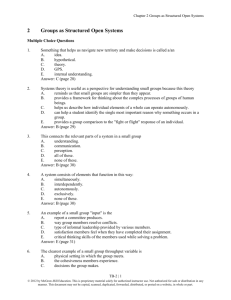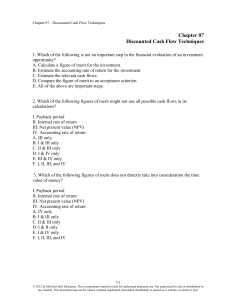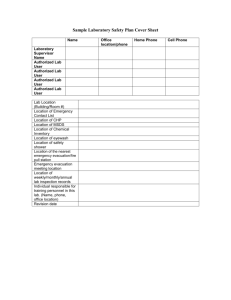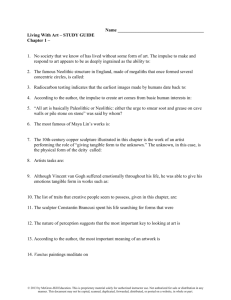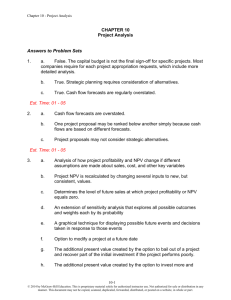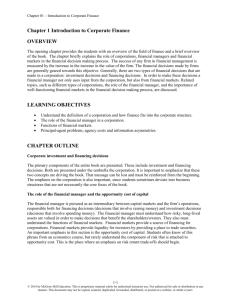International Economics 15E
advertisement
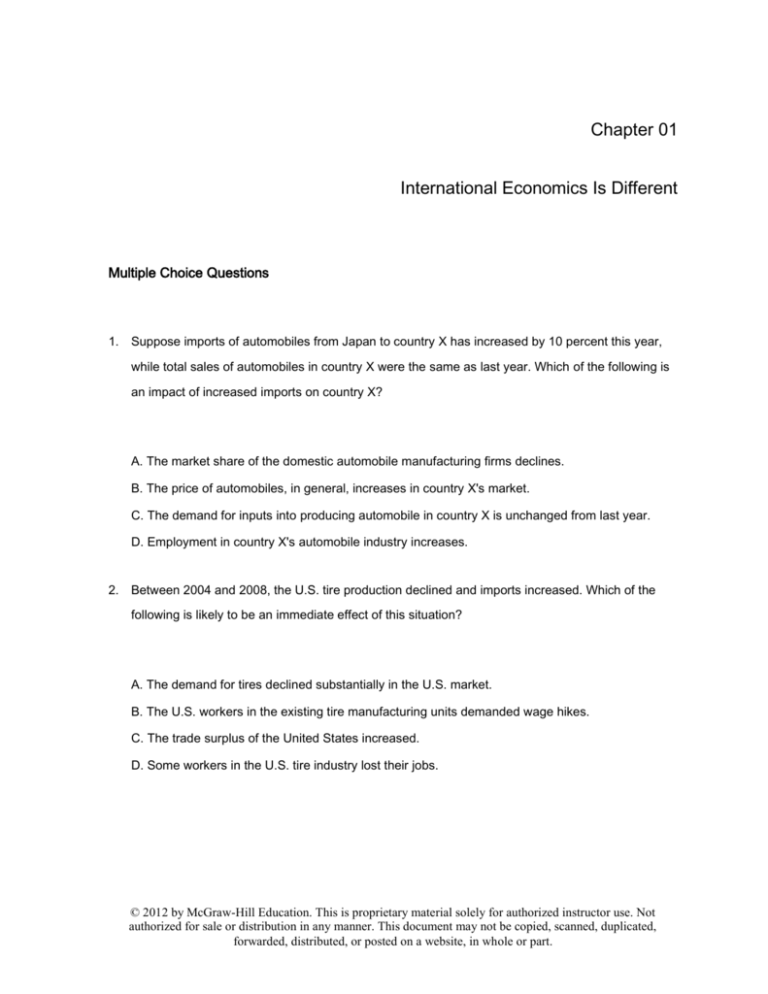
Chapter 01 International Economics Is Different Multiple Choice Questions 1. Suppose imports of automobiles from Japan to country X has increased by 10 percent this year, while total sales of automobiles in country X were the same as last year. Which of the following is an impact of increased imports on country X? A. The market share of the domestic automobile manufacturing firms declines. B. The price of automobiles, in general, increases in country X's market. C. The demand for inputs into producing automobile in country X is unchanged from last year. D. Employment in country X's automobile industry increases. 2. Between 2004 and 2008, the U.S. tire production declined and imports increased. Which of the following is likely to be an immediate effect of this situation? A. The demand for tires declined substantially in the U.S. market. B. The U.S. workers in the existing tire manufacturing units demanded wage hikes. C. The trade surplus of the United States increased. D. Some workers in the U.S. tire industry lost their jobs. © 2012 by McGraw-Hill Education. This is proprietary material solely for authorized instructor use. Not authorized for sale or distribution in any manner. This document may not be copied, scanned, duplicated, forwarded, distributed, or posted on a website, in whole or part. 3. When China joined the World Trade Organization (WTO) in 2001, one of the conditions it accepted was that other countries could impose temporary barriers against surges of imports from China, if the surge causes material harm to their domestic industries. These temporary barriers were known as: A. safeguards. B. subsidies. C. direct taxes. D. value added taxes. 4. In April 2009, the U.S. International Trade Commission (ITC) investigated and concluded that a surge in tire imports from China was harming the U.S. tire industry. Which of the following was recommended by the ITC to President Obama to help the domestic tire industry? A. Personal income tax rates should be reduced immediately. B. Large additional tariffs should be imposed on imports of tires from China. C. Imports of tires from countries other than China should be reduced. D. The dollar should be devalued vis-à-vis the Chinese yuan. 5. When a country raises its import barriers in retaliation for the barriers created by its trading partner, the countries are said to engage in _____. A. a trade war B. currency speculation C. cost arbitrage D. partial specialization © 2012 by McGraw-Hill Education. This is proprietary material solely for authorized instructor use. Not authorized for sale or distribution in any manner. This document may not be copied, scanned, duplicated, forwarded, distributed, or posted on a website, in whole or part. 6. Imposition of a tariff on imports of a product may result in an efficiency loss because: A. there arises an excess demand situation in the market. B. domestic consumers of the product benefit at the expense of foreign producers. C. domestic producers of the product receive a lower price. D. some consumers will no longer be able to purchase the commodity. 7. Which of the following is most likely to be an impact of increasing tariff barriers on good Y in country A? A. The government's tariff revenue will decline. B. The wholesale prices of good Y will increase in country A. C. The demand for good Y will increase in the country. D. The supply of good Y by domestic producers will decline. 8. Which of the following policies is taken by the government of a country to protect domestic industries from foreign competition? A. Revaluing domestic currency vis-à-vis foreign currencies B. Raising taxes on exports C. Raising taxes on imports D. Joining the WTO © 2012 by McGraw-Hill Education. This is proprietary material solely for authorized instructor use. Not authorized for sale or distribution in any manner. This document may not be copied, scanned, duplicated, forwarded, distributed, or posted on a website, in whole or part. 9. A country is better off if the domestic consumers can consume better quality imported products at lower prices. In international economics this captures the essence of: A. tariff policy. B. comparative advantage. C. factor mobility. D. national sovereignty. 10. "Job-seeking immigration brings net economic benefits not only to the immigrants, but also to the receiving country overall." But there are winners and losers within the receiving country. Who among the following can be considered as a winner within the receiving country? A. The workers who compete with the immigrants for jobs B. The government of the receiving country C. The consumers who buy the products that the immigrants help to produce D. None of the above 11. Which of the following is an impact of increased illegal immigration on an economy? A. The rate of inflation in the receiving country increases. B. The demand for labor in the receiving country declines. C. The demand for public goods like education and health care increases. D. The real wage rate of workers increases. © 2012 by McGraw-Hill Education. This is proprietary material solely for authorized instructor use. Not authorized for sale or distribution in any manner. This document may not be copied, scanned, duplicated, forwarded, distributed, or posted on a website, in whole or part. 12. The unskilled wage rate in a country may decline if: A. the corporate taxes are lowered by the government. B. there's increased immigration of low-skilled workers. C. the aggregate demand for goods and services increases in the country. D. the demand for unskilled workers increases. 13. The value of a country's currency in terms of some other country's currency is called _____. A. the stock exchange B. the exchange rate C. the nominal interest rate D. dollarization 14. Which of the following exchange rate policies was undertaken by the Chinese government in 1994? A. The Chinese yuan was revalued against the U.S. dollar. B. A free floating exchange rate regime was adopted. C. The Chinese yuan was revalued against the euro. D. The Chinese yuan was pegged to the U.S. dollar. © 2012 by McGraw-Hill Education. This is proprietary material solely for authorized instructor use. Not authorized for sale or distribution in any manner. This document may not be copied, scanned, duplicated, forwarded, distributed, or posted on a website, in whole or part. 15. In 2004, China had a substantial trade surplus with: A. Russia B. Japan C. the United States D. Brazil 16. "China is not a typical developing nation." Which of the following economic features is most likely to justify this claim? A. China has a large trade deficit with the United States. B. The Chinese government favors a freely floating exchange rate policy. C. China has a high national saving rate. D. The government of China spends a significant portion of its revenue on national defense. 17. Which of following is most likely to happen when the dollar appreciates against the euro? A. There will be a huge inflow of "hot money" to the European nations. B. The prices of American goods in the European countries will decline. C. The prices of European goods in the U.S. markets will decline. D. The rate of inflation in the United States will increase. © 2012 by McGraw-Hill Education. This is proprietary material solely for authorized instructor use. Not authorized for sale or distribution in any manner. This document may not be copied, scanned, duplicated, forwarded, distributed, or posted on a website, in whole or part. 18. The Chinese government's intervention in the foreign exchange market by buying U.S. dollars and selling yuan had the effect of: A. weakening the U.S dollar to increase the U.S. trade deficit with China. B. strengthening the U.S dollar to increase the U.S. trade deficit with China. C. strengthening the yuan to increase the U.S. trade deficit with China. D. weakening the yuan to decrease the U.S. trade deficit with China. 19. On July 21st, 2005, the Chinese government changed the value of the yuan from 8.28 yuan per U.S. dollar to 8.11 yuan per U.S. dollar. One effect of this change should have been: A. an increase in the prices of American goods in the Chinese market. B. an increase in the dollar price of the Chinese goods. C. a decline in the average price level in the United States. D. market pressure to return the rate to 8.28 yuan per dollar. 20. Since the late 1990s, to prevent the yuan from appreciating against the U.S. dollar, the Chinese central bank: A. has been trying to hold euros and British pounds as foreign assets. B. has been buying dollars and selling yuan in the foreign exchange market. C. has purchased Chinese government bonds. D. has been selling foreign assets to replenish it dollar reserves. © 2012 by McGraw-Hill Education. This is proprietary material solely for authorized instructor use. Not authorized for sale or distribution in any manner. This document may not be copied, scanned, duplicated, forwarded, distributed, or posted on a website, in whole or part. 21. The exchange rate policy of a "crawling peg" adopted by the Chinese government in 2005 means that the government: A. allowed small and controlled changes in the exchange-rate value over time. B. pegged the Yuan to the U.S. dollar at the equilibrium exchange rate. C. held a balanced portfolio of assets including a variety of foreign currencies. D. caved in to pressures from foreign governments. 22. The Hong Kong dollar is pegged to the U.S. dollar at a rate of 7.8 Hong Kong dollars to 1 U.S. dollar. Suppose the central bank of Hong Kong changes the exchange value to 7.3 Hong Kong dollars to 1 U.S. dollar. Which of the following is most likely to be true in this context? A. The Hong Kong dollar has been revalued by 0.5 percent. B. The Hong Kong dollar has been devalued by 0.5 percent. C. The Hong Kong dollar has been revalued by 6.4 percent. D. The Hong Kong dollar has been devalued by 6.2 percent. 23. The central bank of Alanza, a developing economy, persistently intervenes in the foreign exchange market to prevent its currency from appreciating against the dollar. Which of the following is the most probable consequence of this intervention by the central bank? A. The money supply in Alanza will decline B. Alanza's exports will decline in the near future C. The rate of inflation in Alanza will increase D. Alanza is most likely to have a trade deficit with the United States © 2012 by McGraw-Hill Education. This is proprietary material solely for authorized instructor use. Not authorized for sale or distribution in any manner. This document may not be copied, scanned, duplicated, forwarded, distributed, or posted on a website, in whole or part. 24. Which of the following factors is most likely to lead to a decline in a country's exports? A. A decrease in corporate taxes B. A decline in the nominal interest rate C. A decline in the input prices D. An appreciation of the domestic currency vis-à-vis foreign currencies 25. Which of the following is a relevant monetary policy during an acute financial crisis in an economy? A. Investment in foreign government bonds should be increased B. The domestic currency should be revalued C. The reserve requirements for the commercial banks should be increased D. The nominal interest rates should be lowered 26. Which among the following was a policy that the Federal Reserve used to alleviate the global credit crunch that began in August 2007? A. Decreased U.S. taxes B. Revalued the dollar against the euro and other major currencies C. Began the use of liquidity swaps with foreign central banks D. Raised the interest rate target © 2012 by McGraw-Hill Education. This is proprietary material solely for authorized instructor use. Not authorized for sale or distribution in any manner. This document may not be copied, scanned, duplicated, forwarded, distributed, or posted on a website, in whole or part. 27. A computer programmer working in India relocates to the United States. This is an example of: A. international outsourcing. B. factor mobility. C. cross-border trade. D. factor intensity reversal. 28. _____ is considered to be the least mobile factor internationally. A. Labor B. Capital C. Entrepreneurship D. Land 29. Which of the following is NOT a fiscal policy? A. Increasing tariffs to reduce imports B. Offering subsidies to export firms C. Increasing the money supply to expand aggregate demand D. Lowering personal tax rates to influence labor supply 30. The supply of money in a country like the United States is controlled by the: A. central bank of the country. B. political party in charge of the government of the country. C. International Monetary Fund. D. commercial banks in the country. © 2012 by McGraw-Hill Education. This is proprietary material solely for authorized instructor use. Not authorized for sale or distribution in any manner. This document may not be copied, scanned, duplicated, forwarded, distributed, or posted on a website, in whole or part. True / False Questions 31. The net efficiency loss from a tariff can occur even if the government revenue from the tariff is greater than zero. True False 32. As U.S. imports of Chinese tires decreased when the United States imposed tariffs in 2009, the imports of tires from other countries like South Korea, Taiwan, Indonesia, and Thailand also decreased. True False 33. When the U.S. government imposed high tariffs on imports of tires from China in 2009, the Chinese government retaliated by increasing taxes on the imports of chicken from the United States. True False 34. For most large industrialized countries, the country's foreign-born population is more than a tenth of the country's total population. True False 35. The World Trade Organization, the International Monetary Fund, the United Nations, and the World Bank control the international economy by imposing binding rules that control international trade and foreign exchange markets. True False © 2012 by McGraw-Hill Education. This is proprietary material solely for authorized instructor use. Not authorized for sale or distribution in any manner. This document may not be copied, scanned, duplicated, forwarded, distributed, or posted on a website, in whole or part. 36. National sovereignty means that no one person or group is in charge of the international economy. True False 37. Evidence shows that the Chinese Yuan was substantially overvalued against the U.S. dollar in mid-2005. True False 38. During 2001-2004 the European Union had a large trade surplus with China. True False 39. If the dollar per pound exchange rate changes from $1.50 per pound to $2 per pound, it implies that the dollar has appreciated against the pound. True False 40. Under a fixed exchange rate system, the revaluation of the local currency against the dollar would result in an improvement in the country's trade balance with the United States. True False 41. In September 2008 the investment bank Lehman Brothers lost its access to short-term funding and averted failure when it was purchased by J.P. Morgan Chase. True False 42. A country cannot set its own policies toward the international movement of productive resources. True False © 2012 by McGraw-Hill Education. This is proprietary material solely for authorized instructor use. Not authorized for sale or distribution in any manner. This document may not be copied, scanned, duplicated, forwarded, distributed, or posted on a website, in whole or part. 43. Although financial capital is relatively mobile as an input, it is subject to a "home bias" in which people prefer to invest within their own country. True False 44. Banks open branches in countries where profits are taxed less and their books of accounts are less scrutinized. True False 45. Monetary policies adopted by a country do not affect its trading partners as long as the partner countries use different currencies. True False Essay Questions 46. Explain why the United Steelworkers union filed a petition with the U.S. government about tire trade in April 2009. © 2012 by McGraw-Hill Education. This is proprietary material solely for authorized instructor use. Not authorized for sale or distribution in any manner. This document may not be copied, scanned, duplicated, forwarded, distributed, or posted on a website, in whole or part. 47. How was the possibility of a trade war created between the U.S. and China after the U.S. government raised the tariff rates on imports of Chinese tires as per the recommendations of the U.S. International Trade Commission (ITC) in 2009? 48. "Job-seeking immigration brings net economic benefits not only to the immigrants, but also to the receiving country overall." Justify the statement. © 2012 by McGraw-Hill Education. This is proprietary material solely for authorized instructor use. Not authorized for sale or distribution in any manner. This document may not be copied, scanned, duplicated, forwarded, distributed, or posted on a website, in whole or part. 49. In mid-2010, the Chinese government ended its fixed exchange rate to the U.S. dollar and began to allow the yuan to appreciate gradually. How would this shift affect the Chinese economy? 50. What was the initial reaction of the Fed and the other central banks in the first phase of financial crisis in 2007? © 2012 by McGraw-Hill Education. This is proprietary material solely for authorized instructor use. Not authorized for sale or distribution in any manner. This document may not be copied, scanned, duplicated, forwarded, distributed, or posted on a website, in whole or part. Chapter 01 International Economics Is Different Answer Key Multiple Choice Questions 1. Suppose imports of automobiles from Japan to country X has increased by 10 percent this year, while total sales of automobiles in country X were the same as last year. Which of the following is an impact of increased imports on country X? A. The market share of the domestic automobile manufacturing firms declines. B. The price of automobiles, in general, increases in country X's market. C. The demand for inputs into producing automobile in country X is unchanged from last year. D. Employment in country X's automobile industry increases. Difficulty Level: 1 2. Between 2004 and 2008, the U.S. tire production declined and imports increased. Which of the following is likely to be an immediate effect of this situation? A. The demand for tires declined substantially in the U.S. market. B. The U.S. workers in the existing tire manufacturing units demanded wage hikes. C. The trade surplus of the United States increased. D. Some workers in the U.S. tire industry lost their jobs. Difficulty Level: 1 © 2012 by McGraw-Hill Education. This is proprietary material solely for authorized instructor use. Not authorized for sale or distribution in any manner. This document may not be copied, scanned, duplicated, forwarded, distributed, or posted on a website, in whole or part. 3. When China joined the World Trade Organization (WTO) in 2001, one of the conditions it accepted was that other countries could impose temporary barriers against surges of imports from China, if the surge causes material harm to their domestic industries. These temporary barriers were known as: A. safeguards. B. subsidies. C. direct taxes. D. value added taxes. Difficulty Level: 1 4. In April 2009, the U.S. International Trade Commission (ITC) investigated and concluded that a surge in tire imports from China was harming the U.S. tire industry. Which of the following was recommended by the ITC to President Obama to help the domestic tire industry? A. Personal income tax rates should be reduced immediately. B. Large additional tariffs should be imposed on imports of tires from China. C. Imports of tires from countries other than China should be reduced. D. The dollar should be devalued vis-à-vis the Chinese yuan. Difficulty Level: 1 © 2012 by McGraw-Hill Education. This is proprietary material solely for authorized instructor use. Not authorized for sale or distribution in any manner. This document may not be copied, scanned, duplicated, forwarded, distributed, or posted on a website, in whole or part. 5. When a country raises its import barriers in retaliation for the barriers created by its trading partner, the countries are said to engage in _____. A. a trade war B. currency speculation C. cost arbitrage D. partial specialization Difficulty Level: 1 6. Imposition of a tariff on imports of a product may result in an efficiency loss because: A. there arises an excess demand situation in the market. B. domestic consumers of the product benefit at the expense of foreign producers. C. domestic producers of the product receive a lower price. D. some consumers will no longer be able to purchase the commodity. Difficulty Level: 1 7. Which of the following is most likely to be an impact of increasing tariff barriers on good Y in country A? A. The government's tariff revenue will decline. B. The wholesale prices of good Y will increase in country A. C. The demand for good Y will increase in the country. D. The supply of good Y by domestic producers will decline. Difficulty Level: 1 © 2012 by McGraw-Hill Education. This is proprietary material solely for authorized instructor use. Not authorized for sale or distribution in any manner. This document may not be copied, scanned, duplicated, forwarded, distributed, or posted on a website, in whole or part. 8. Which of the following policies is taken by the government of a country to protect domestic industries from foreign competition? A. Revaluing domestic currency vis-à-vis foreign currencies B. Raising taxes on exports C. Raising taxes on imports D. Joining the WTO Difficulty Level: 1 9. A country is better off if the domestic consumers can consume better quality imported products at lower prices. In international economics this captures the essence of: A. tariff policy. B. comparative advantage. C. factor mobility. D. national sovereignty. Difficulty Level: 2 10. "Job-seeking immigration brings net economic benefits not only to the immigrants, but also to the receiving country overall." But there are winners and losers within the receiving country. Who among the following can be considered as a winner within the receiving country? A. The workers who compete with the immigrants for jobs B. The government of the receiving country C. The consumers who buy the products that the immigrants help to produce D. None of the above Difficulty Level: 1 © 2012 by McGraw-Hill Education. This is proprietary material solely for authorized instructor use. Not authorized for sale or distribution in any manner. This document may not be copied, scanned, duplicated, forwarded, distributed, or posted on a website, in whole or part. 11. Which of the following is an impact of increased illegal immigration on an economy? A. The rate of inflation in the receiving country increases. B. The demand for labor in the receiving country declines. C. The demand for public goods like education and health care increases. D. The real wage rate of workers increases. Difficulty Level: 1 12. The unskilled wage rate in a country may decline if: A. the corporate taxes are lowered by the government. B. there's increased immigration of low-skilled workers. C. the aggregate demand for goods and services increases in the country. D. the demand for unskilled workers increases. Difficulty Level: 1 13. The value of a country's currency in terms of some other country's currency is called _____. A. the stock exchange B. the exchange rate C. the nominal interest rate D. dollarization Difficulty Level: 1 © 2012 by McGraw-Hill Education. This is proprietary material solely for authorized instructor use. Not authorized for sale or distribution in any manner. This document may not be copied, scanned, duplicated, forwarded, distributed, or posted on a website, in whole or part. 14. Which of the following exchange rate policies was undertaken by the Chinese government in 1994? A. The Chinese yuan was revalued against the U.S. dollar. B. A free floating exchange rate regime was adopted. C. The Chinese yuan was revalued against the euro. D. The Chinese yuan was pegged to the U.S. dollar. Difficulty Level: 1 15. In 2004, China had a substantial trade surplus with: A. Russia B. Japan C. the United States D. Brazil Difficulty Level: 1 16. "China is not a typical developing nation." Which of the following economic features is most likely to justify this claim? A. China has a large trade deficit with the United States. B. The Chinese government favors a freely floating exchange rate policy. C. China has a high national saving rate. D. The government of China spends a significant portion of its revenue on national defense. Difficulty Level: 1 © 2012 by McGraw-Hill Education. This is proprietary material solely for authorized instructor use. Not authorized for sale or distribution in any manner. This document may not be copied, scanned, duplicated, forwarded, distributed, or posted on a website, in whole or part. 17. Which of following is most likely to happen when the dollar appreciates against the euro? A. There will be a huge inflow of "hot money" to the European nations. B. The prices of American goods in the European countries will decline. C. The prices of European goods in the U.S. markets will decline. D. The rate of inflation in the United States will increase. Difficulty Level: 2 18. The Chinese government's intervention in the foreign exchange market by buying U.S. dollars and selling yuan had the effect of: A. weakening the U.S dollar to increase the U.S. trade deficit with China. B. strengthening the U.S dollar to increase the U.S. trade deficit with China. C. strengthening the yuan to increase the U.S. trade deficit with China. D. weakening the yuan to decrease the U.S. trade deficit with China. Difficulty Level: 2 19. On July 21st, 2005, the Chinese government changed the value of the yuan from 8.28 yuan per U.S. dollar to 8.11 yuan per U.S. dollar. One effect of this change should have been: A. an increase in the prices of American goods in the Chinese market. B. an increase in the dollar price of the Chinese goods. C. a decline in the average price level in the United States. D. market pressure to return the rate to 8.28 yuan per dollar. Difficulty Level: 2 © 2012 by McGraw-Hill Education. This is proprietary material solely for authorized instructor use. Not authorized for sale or distribution in any manner. This document may not be copied, scanned, duplicated, forwarded, distributed, or posted on a website, in whole or part. 20. Since the late 1990s, to prevent the yuan from appreciating against the U.S. dollar, the Chinese central bank: A. has been trying to hold euros and British pounds as foreign assets. B. has been buying dollars and selling yuan in the foreign exchange market. C. has purchased Chinese government bonds. D. has been selling foreign assets to replenish it dollar reserves. Difficulty Level: 2 21. The exchange rate policy of a "crawling peg" adopted by the Chinese government in 2005 means that the government: A. allowed small and controlled changes in the exchange-rate value over time. B. pegged the Yuan to the U.S. dollar at the equilibrium exchange rate. C. held a balanced portfolio of assets including a variety of foreign currencies. D. caved in to pressures from foreign governments. Difficulty Level: 1 22. The Hong Kong dollar is pegged to the U.S. dollar at a rate of 7.8 Hong Kong dollars to 1 U.S. dollar. Suppose the central bank of Hong Kong changes the exchange value to 7.3 Hong Kong dollars to 1 U.S. dollar. Which of the following is most likely to be true in this context? A. The Hong Kong dollar has been revalued by 0.5 percent. B. The Hong Kong dollar has been devalued by 0.5 percent. C. The Hong Kong dollar has been revalued by 6.4 percent. D. The Hong Kong dollar has been devalued by 6.2 percent. Difficulty Level: 3 © 2012 by McGraw-Hill Education. This is proprietary material solely for authorized instructor use. Not authorized for sale or distribution in any manner. This document may not be copied, scanned, duplicated, forwarded, distributed, or posted on a website, in whole or part. 23. The central bank of Alanza, a developing economy, persistently intervenes in the foreign exchange market to prevent its currency from appreciating against the dollar. Which of the following is the most probable consequence of this intervention by the central bank? A. The money supply in Alanza will decline B. Alanza's exports will decline in the near future C. The rate of inflation in Alanza will increase D. Alanza is most likely to have a trade deficit with the United States Difficulty Level: 2 24. Which of the following factors is most likely to lead to a decline in a country's exports? A. A decrease in corporate taxes B. A decline in the nominal interest rate C. A decline in the input prices D. An appreciation of the domestic currency vis-à-vis foreign currencies Difficulty Level: 2 25. Which of the following is a relevant monetary policy during an acute financial crisis in an economy? A. Investment in foreign government bonds should be increased B. The domestic currency should be revalued C. The reserve requirements for the commercial banks should be increased D. The nominal interest rates should be lowered Difficulty Level: 1 © 2012 by McGraw-Hill Education. This is proprietary material solely for authorized instructor use. Not authorized for sale or distribution in any manner. This document may not be copied, scanned, duplicated, forwarded, distributed, or posted on a website, in whole or part. 26. Which among the following was a policy that the Federal Reserve used to alleviate the global credit crunch that began in August 2007? A. Decreased U.S. taxes B. Revalued the dollar against the euro and other major currencies C. Began the use of liquidity swaps with foreign central banks D. Raised the interest rate target Difficulty Level: 1 27. A computer programmer working in India relocates to the United States. This is an example of: A. international outsourcing. B. factor mobility. C. cross-border trade. D. factor intensity reversal. Difficulty Level: 2 28. _____ is considered to be the least mobile factor internationally. A. Labor B. Capital C. Entrepreneurship D. Land Difficulty Level: 1 © 2012 by McGraw-Hill Education. This is proprietary material solely for authorized instructor use. Not authorized for sale or distribution in any manner. This document may not be copied, scanned, duplicated, forwarded, distributed, or posted on a website, in whole or part. 29. Which of the following is NOT a fiscal policy? A. Increasing tariffs to reduce imports B. Offering subsidies to export firms C. Increasing the money supply to expand aggregate demand D. Lowering personal tax rates to influence labor supply Difficulty Level: 2 30. The supply of money in a country like the United States is controlled by the: A. central bank of the country. B. political party in charge of the government of the country. C. International Monetary Fund. D. commercial banks in the country. Difficulty Level: 1 True / False Questions 31. The net efficiency loss from a tariff can occur even if the government revenue from the tariff is greater than zero. TRUE Difficulty Level: 1 © 2012 by McGraw-Hill Education. This is proprietary material solely for authorized instructor use. Not authorized for sale or distribution in any manner. This document may not be copied, scanned, duplicated, forwarded, distributed, or posted on a website, in whole or part. 32. As U.S. imports of Chinese tires decreased when the United States imposed tariffs in 2009, the imports of tires from other countries like South Korea, Taiwan, Indonesia, and Thailand also decreased. FALSE Difficulty Level: 1 33. When the U.S. government imposed high tariffs on imports of tires from China in 2009, the Chinese government retaliated by increasing taxes on the imports of chicken from the United States. TRUE Difficulty Level: 1 34. For most large industrialized countries, the country's foreign-born population is more than a tenth of the country's total population. TRUE Difficulty Level: 1 35. The World Trade Organization, the International Monetary Fund, the United Nations, and the World Bank control the international economy by imposing binding rules that control international trade and foreign exchange markets. FALSE Difficulty Level: 2 © 2012 by McGraw-Hill Education. This is proprietary material solely for authorized instructor use. Not authorized for sale or distribution in any manner. This document may not be copied, scanned, duplicated, forwarded, distributed, or posted on a website, in whole or part. 36. National sovereignty means that no one person or group is in charge of the international economy. TRUE Difficulty Level: 1 37. Evidence shows that the Chinese Yuan was substantially overvalued against the U.S. dollar in mid-2005. FALSE Difficulty Level: 2 38. During 2001-2004 the European Union had a large trade surplus with China. FALSE Difficulty Level: 1 39. If the dollar per pound exchange rate changes from $1.50 per pound to $2 per pound, it implies that the dollar has appreciated against the pound. FALSE Difficulty Level: 2 40. Under a fixed exchange rate system, the revaluation of the local currency against the dollar would result in an improvement in the country's trade balance with the United States. FALSE Difficulty Level: 2 © 2012 by McGraw-Hill Education. This is proprietary material solely for authorized instructor use. Not authorized for sale or distribution in any manner. This document may not be copied, scanned, duplicated, forwarded, distributed, or posted on a website, in whole or part. 41. In September 2008 the investment bank Lehman Brothers lost its access to short-term funding and averted failure when it was purchased by J.P. Morgan Chase. FALSE Difficulty Level: 1 42. A country cannot set its own policies toward the international movement of productive resources. FALSE Difficulty Level: 1 43. Although financial capital is relatively mobile as an input, it is subject to a "home bias" in which people prefer to invest within their own country. TRUE Difficulty Level: 1 44. Banks open branches in countries where profits are taxed less and their books of accounts are less scrutinized. TRUE Difficulty Level: 1 45. Monetary policies adopted by a country do not affect its trading partners as long as the partner countries use different currencies. FALSE Difficulty Level: 1 © 2012 by McGraw-Hill Education. This is proprietary material solely for authorized instructor use. Not authorized for sale or distribution in any manner. This document may not be copied, scanned, duplicated, forwarded, distributed, or posted on a website, in whole or part. Essay Questions 46. Explain why the United Steelworkers union filed a petition with the U.S. government about tire trade in April 2009. During 2004-2008 the quantity of tires imported from China tripled. Such a large increase in imports had major implications for the U.S. tire industry. With the increase in imports, domestic production of tires declined considerably, and thousands of workers in the domestic tire industry lost their jobs. Four U.S. tire factories closed. About half of the tire workers in the United States are members of the United Steelworkers union, and the union filed a petition with the U.S. government against the surge in Chinese imports, to protect jobs and U.S. tire production. The union requested temporary barriers against the surge in imports from China because the imports were causing material harm to the domestic tire industry. Difficulty Level: 1 © 2012 by McGraw-Hill Education. This is proprietary material solely for authorized instructor use. Not authorized for sale or distribution in any manner. This document may not be copied, scanned, duplicated, forwarded, distributed, or posted on a website, in whole or part. 47. How was the possibility of a trade war created between the U.S. and China after the U.S. government raised the tariff rates on imports of Chinese tires as per the recommendations of the U.S. International Trade Commission (ITC) in 2009? In response to the petition filed by the United Steelworkers union, the U.S. International Trade Commission investigated and concluded that a surge in tire imports from China was adversely affecting the U.S. tire industry. The ITC recommended that the U.S. President impose high tariffs on imports of tires from China. In September 2009, President Obama decided to impose tariffs on imports of Chinese tires. After the tariffs were imposed, imports of tires from China declined significantly. As a result the tire manufacturers in China lost sales and market share in the U.S. market. The Chinese government expressed its unhappiness with the harm to its producers and workers by retaliating. The Chinese government increased tariffs on import of some goods from the United States, including chicken. A U.S. trade official said that the U.S. could also react to the retaliatory actions of the Chinese government. This created a possibility of trade war between China and the United States, in which each would react with rising import barriers that could have led to large losses in both countries. Difficulty Level: 2 © 2012 by McGraw-Hill Education. This is proprietary material solely for authorized instructor use. Not authorized for sale or distribution in any manner. This document may not be copied, scanned, duplicated, forwarded, distributed, or posted on a website, in whole or part. 48. "Job-seeking immigration brings net economic benefits not only to the immigrants, but also to the receiving country overall." Justify the statement. Immigration leaves some better off and some worse off in the receiving country. The winners include the firms that employ the immigrants and the consumers who buy the products that the immigrants help to produce. The losers are the workers who compete with the immigrants for jobs. For the industrialized countries, the real wages of low-skilled workers have been depressed by the influx of low-skilled workers from developing countries. However, it has been observed that the net effect of immigration on the receiving country is positive. The economic benefits have been higher than the economic and social costs of immigration. Difficulty Level: 1 © 2012 by McGraw-Hill Education. This is proprietary material solely for authorized instructor use. Not authorized for sale or distribution in any manner. This document may not be copied, scanned, duplicated, forwarded, distributed, or posted on a website, in whole or part. 49. In mid-2010, the Chinese government ended its fixed exchange rate to the U.S. dollar and began to allow the yuan to appreciate gradually. How would this shift affect the Chinese economy? From mid-2008 to mid-2010, the Chinese government kept the exchange rate value of the yuan fixed to the U.S. dollar. To defend the fixed rate, the Chinese government had to continuously buy dollars and sell yuan in the foreign exchange market. As China's central bank added yuan to the economy through this intervention, the money supply in China grew rapidly, encouraging local borrowing and spending that resulted in a higher inflation rate in China. Given these conditions, the increase in the exchange-rate value of the yuan can help the government manage its domestic economy better, in three ways. First, it would lower import prices in China, thereby reducing inflation pressures in the country. Second, it could reduce the growth of China's exports, removing some of the demand pressure on the prices of domestic resources and products. Third, it reduces the amount of intervention needed, reducing the pressure on the growth of China's domestic money supply. Difficulty Level: 1 © 2012 by McGraw-Hill Education. This is proprietary material solely for authorized instructor use. Not authorized for sale or distribution in any manner. This document may not be copied, scanned, duplicated, forwarded, distributed, or posted on a website, in whole or part. 50. What was the initial reaction of the Fed and the other central banks in the first phase of financial crisis in 2007? In the first phase of the financial crisis, the key issue seemed to be limited access to funding for banks and other financial institutions. The U.S. Federal Reserve and other central banks tried to stabilize the financial sector and the economy using expansionary monetary policy. The Fed reduced its interest rate target significantly. However, banks and investors continued to be reluctant to lend and invest. Therefore, to induce lending by financial institutions, the Fed introduced two unusual programs to provide additional liquidity. First, it began to auction funds to banks using the Term Auction Facility, to overcome banks' reluctance to borrow from the Fed using traditional discount loans. Second, the Fed began foreign central bank liquidity swaps with the European Central Bank and the Swiss central bank. The foreign central banks could use the swaps to obtain dollars, which they could then lend to their own banks, which were having trouble obtaining dollars through normal inter-bank borrowing. Difficulty Level: 1 © 2012 by McGraw-Hill Education. This is proprietary material solely for authorized instructor use. Not authorized for sale or distribution in any manner. This document may not be copied, scanned, duplicated, forwarded, distributed, or posted on a website, in whole or part.
